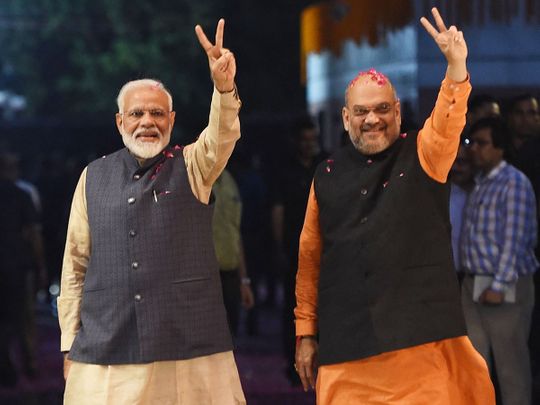
We are often told, with good reason, that India’s ruling Bharatiya Janata Party uses its ideology of Hindu nationalism to win elections. Ideological assertion helps “polarise” the electorate, and the BJP wins. How, then, do we explain the BJP’s downplaying of Hindutva in the Karnataka assembly elections?
The “halal-hijab” kind of issues, or even the debates around the legacy of Tipu Sultan, don’t seem as dominant in the Karnataka election as they were in the state’s politics around a year ago. This is not to say there is no Hindutva at all. Most notably, there is the issue of a 4 per cent job quota for Muslims the BJP wants to end. Yet even in coastal Karnataka, a bastion of Hindutva politics, the BJP is moderating its Hindutva pitch.
The truth is, this is not a unique phenomenon. We may recall that even before the West Bengal elections in 2022, the BJP did not live up to the apprehension of critics that it would raise the Hindutva pitch. The contentious issue of the Citizenship Amendment Act, or CAA, was forgotten. This issue, many felt, was chiefly raised to reap political dividends in West Bengal.
Keeping your core voters happy is as important as pulling in the swing voter...If the base is all charged up and motivated, it goes out in society and acts as the amplifier of your voice.
In fact, this is true of most elections. The BJP will make a few headline-grabbing Hindutva statements, but the “polarisation” is much more when it isn’t election time. Take the last two general elections. In 2014, the Modi campaign pitch centred around the promise of exponential development and economic progress. The 2019 campaign was around national security and welfare schemes.
Whether it was Uttar Pradesh or Gujarat, we saw last year how the promised Hindutva hardline quietly petered out before an election. When Hindutva raises its pitch, the election is usually at least a year away.
The zigzag approach
The tension between moderate and hardline Hindutva is an old one. This tension was behind the BJP’s indecision on how big they should go on the Ram Mandir issue in the 1980s. When they did, it reaped rich dividends. But it didn’t take them to power. They had to take a moderate approach, put the hardline issues on the back burner, and present a moderate “mukhauta” or mask in the form of Atal Behari Vajpayee to earn the trust of coalition partners. And then again they were back to a hard line with LK Advani and Narendra Modi, who again softened his approach to go big on development.
What you see here is a pattern, a zigzag pattern. The path is not linear. The question is, what determines the twists and turns along the highway to electoral success?
The answer lies in the contradiction between core and swing voters. Core voters care about ideology the most, swing voters care about day-to-day issues the most. Core voters are the cheesecake, swing voters the topping. The cheesecake has to be baked first, but finally it is that topping that makes the cheesecake irresistible.
When it is not election time, the BJP works on charging up its core vote base. When elections are near, it wants to be seen as the party of governance to attract the swing voter.
Charging up the base
This tension isn’t always an easy one to resolve, and from time to time, the political project may collapse between two stools. This is what happened to the BJP right after the Ram Mandir movement, or after the Vajpayee era when core voters felt they had been taken for granted.
Keeping your core voters happy is as important as pulling in the swing voter. Charging up the base, as they say in American politics. If the base is all charged up and motivated, it goes out in society and acts as the amplifier of your voice. This is why parties decline when they don’t assert their ideology: there is no motivated base to spread your word to the rest of society. The Aam Aadmi Party is a good example of a party that frittered away an ideological base it had gained in the Lokpal movement in 2011.
The other side of the coin is that when you are so immersed in your ideology and your base, swing voters find you alienating. You could say this about Communist parties and even the Mayawati-led Bahujan Samaj Party, whose experiments to pull in the swing voter succeeded briefly in 2007.
Ideology versus strategy
This is why the BJP’s hyping up of Hindutva or downplaying it is not a question of ideological commitment. It is a matter of strategy.
How does this tension between ideology and strategy play out in opposition parties?
The Congress could argue that the Rahul Gandhi-led Bharat Jodo Yatra was an exercise in charging up its ideological base and that it is now focusing on pulling in the swing voter in Karnataka through promises of governance and development.
Except for the example of the Bharat Jodo Yatra, we see opposition parties often too confused about ideology and strategy. They could learn from the BJP, which pushes the ideological envelope after winning an election, but when it comes to elections the party lets tactical strategy dictate the pitch to voters.









